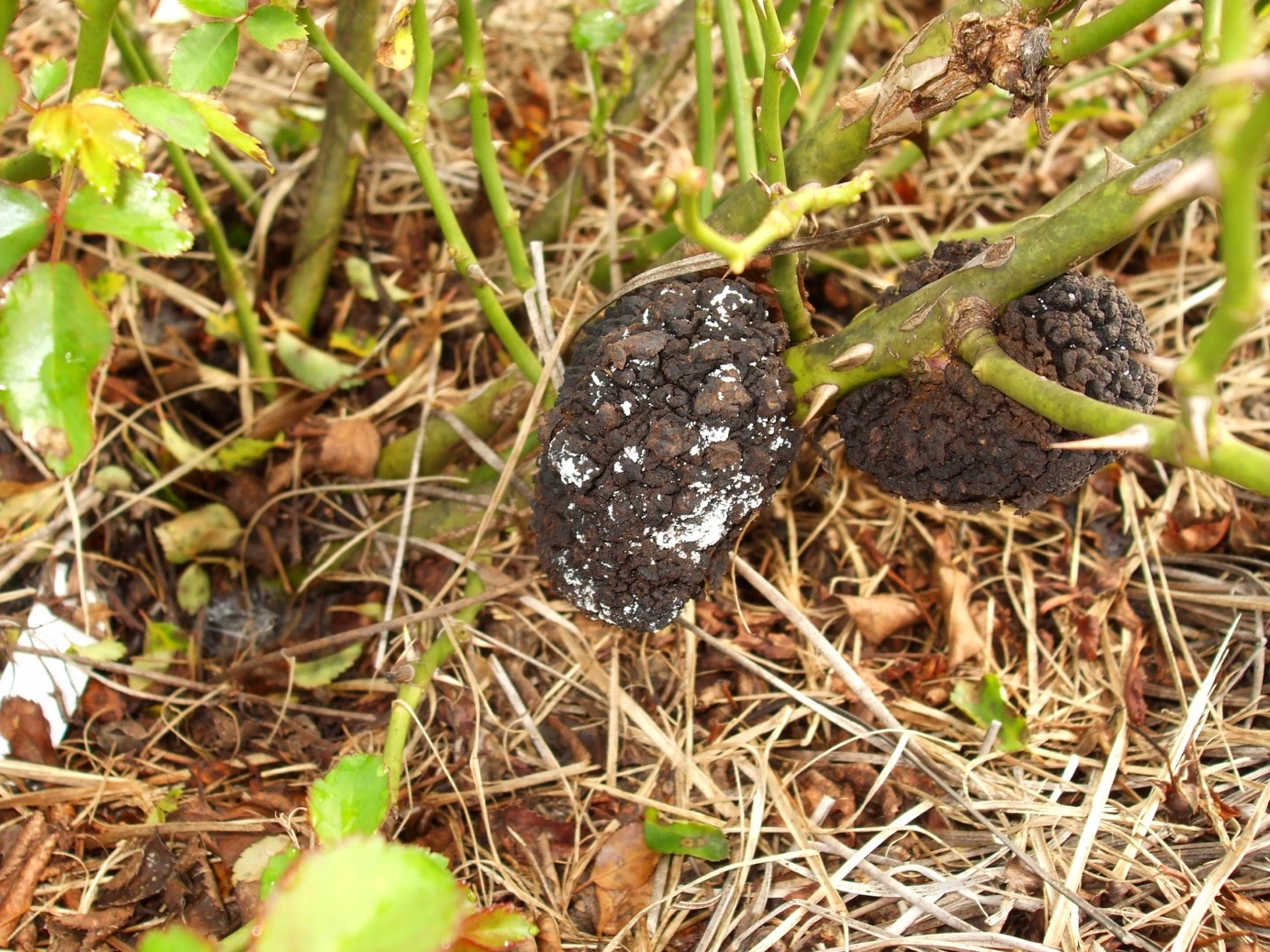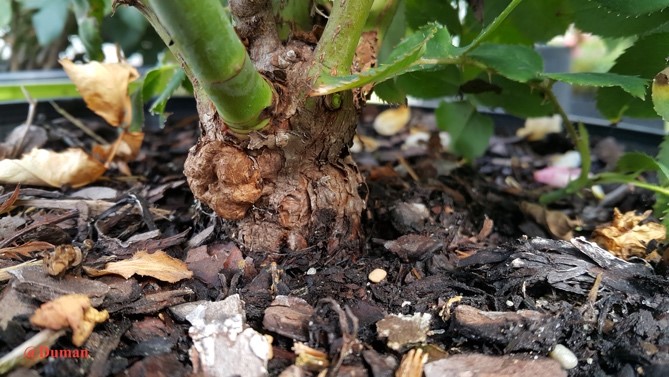
Crown gall symptoms on roses caused by the bacterium Agrobacterium tumefaciens (Rhizobium radiobacter) – Photo credits: Kamil Duman
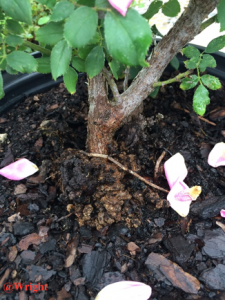
A plant with a mature gall that is potentially releasing the crown gall bacterium into the potting media. Photo credits: Susannah Wright
For gardeners, rose enthusiasts and rosarians, each of the many rose diseases is as important as the others. But we can say for sure Crown Gall is one of the most unsightly of the many rose diseases that can been seen currently.
The disease got this name from the large tumor-like swellings (galls) that typically occur at the crown of the plant, just above the soil level. The cause of crown gall disease is a bacterium that resides in the soil, Agrobacterium tumefaciens (updated scientific name Rhizobium radiobacter).
SYMPTOMS
Galls or overgrowth (1/4 inch to several inches in diameter) of host plant tissue typically form at the soil line but also can form on branches or roots. Galls are initially white, spherical, and soft but darken with age as outer cells die. It can either be almost entirely on the surface of the plant and easily detached or can be almost indistinguishable from normal plant tissue except for its greatly enlarged appearance.
The bacterium that causes Crown Gall disease survives and persists in the soil for up to 3 years. It can invade recent wounds on the branches or roots. Swelling can be seen as early as 14 days following entry of the bacterium into the plant. The tissue near the gall can be crushed due to rapid cell enlargement. If vascular tissue is crushed, wilting can result from the restricted water movement.
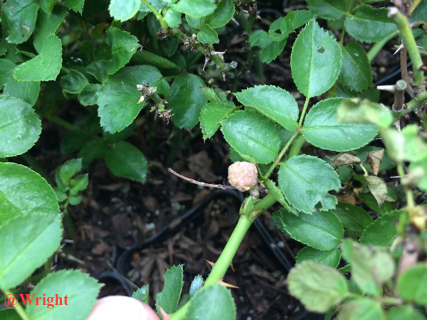
Early stage symptom of Crown Gall on roses can be noticed as the small white galls. Photo credits: Susannah Wright
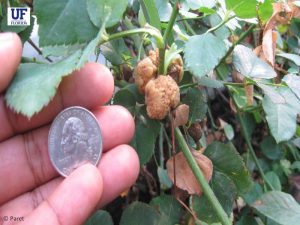
The galls can enlarge to a quarter size in a short period of time from the initial small galls. Photo credits: Mathews Paret
ABOUT THE BACTERIUM
Agrobacterium uses its genes as a weapon to attack plants. It enters the plant mostly from the soil through wounds on the roots or lower stem or from the branches during plant pruning. Symptoms are caused by the insertion of a small segment of DNA (known as the T-DNA), from a plasmid, into the host plant cell, which is incorporated into the plant genome. When the plasmid links up with the plants own DNA, the altered plant cells start dividing rapidly and uncontrollably, and the root or stem develops a tumor-like swelling.
Galls can range from pea size to softball size. Tiny cracks from freezing temperatures or wound sites can be the site of gall formation. Once the wound compounds are generated, the bacteria detach from the xylem cell walls and are carried upward with water during evapotranspiration to the wound site where they initiate galls. One of the common ways of the spread of the disease is by pruning infected plants and moving the bacterium accidentally while pruning nearby healthy plants.
The crown gall bacterium is a soil pathogen, which means main inoculum source is soil. The bacterium can overwinter in infested soils, where it can live as a saprophyte for several years. The bacterium can easily during field preparation, pruning and irrigation. Insects, nematodes and grafting materials, can also transfer the bacterium.
HOW CAN YOU MANAGE ROSE CROWN GALL DISEASE
- Plant only disease-free roses. Check very carefully before you buy plants for any kind of galls in the crown or branches. Use good sanitation practices in handling roses.
- Plant in clean soil. Avoid areas with a history of crown gall infestation.
- Avoid fields with heavy infestations of root-attacking insects and nematodes.
- Select well-drained soil and irrigate from clean water sources.
- Keep grafts and buds well above the soil line.
- Destroy diseased plants as soon as you notice them to avoid cross-contaminating other plants, or pruning equipment. Also, do not keep infected plants with healthy plants, as the likelihood of accidental transmission through pruning is high.
- Avoid mechanical injury to plants from tillage and hoeing. Provide winter protection so that the bark does not crack.
- Disinfect pruning tools between plants. disinfect budding/grafting tools before and after use. Bleach (10%; equivalent to 0.6% sodium hypochlorite), or quaternary ammonium-based sanitizer are effective as disinfectants. Make sure to prepare fresh stock routinely.
- If crown gall plants are noted, please let your local county extension agent know about it and they will be able to contact us for additional site-specific management plans if needed.

Gall formation at pruning sites indicating contamination of the plant during pruning. Photo credits: Kamil Duman
Authors: Kamil Duman, Susannah Wright, Fanny Iriarte, Barron Riddle, Gary Knox and Mathews Paret, University of Florida – NFREC, Quincy, FL
- Foodscaping – Create Beauty and Bounty - April 7, 2022
- Cold-hardy Bromeliads for North Florida - December 15, 2021
- How to Hunt for “New” Plants - September 2, 2021

